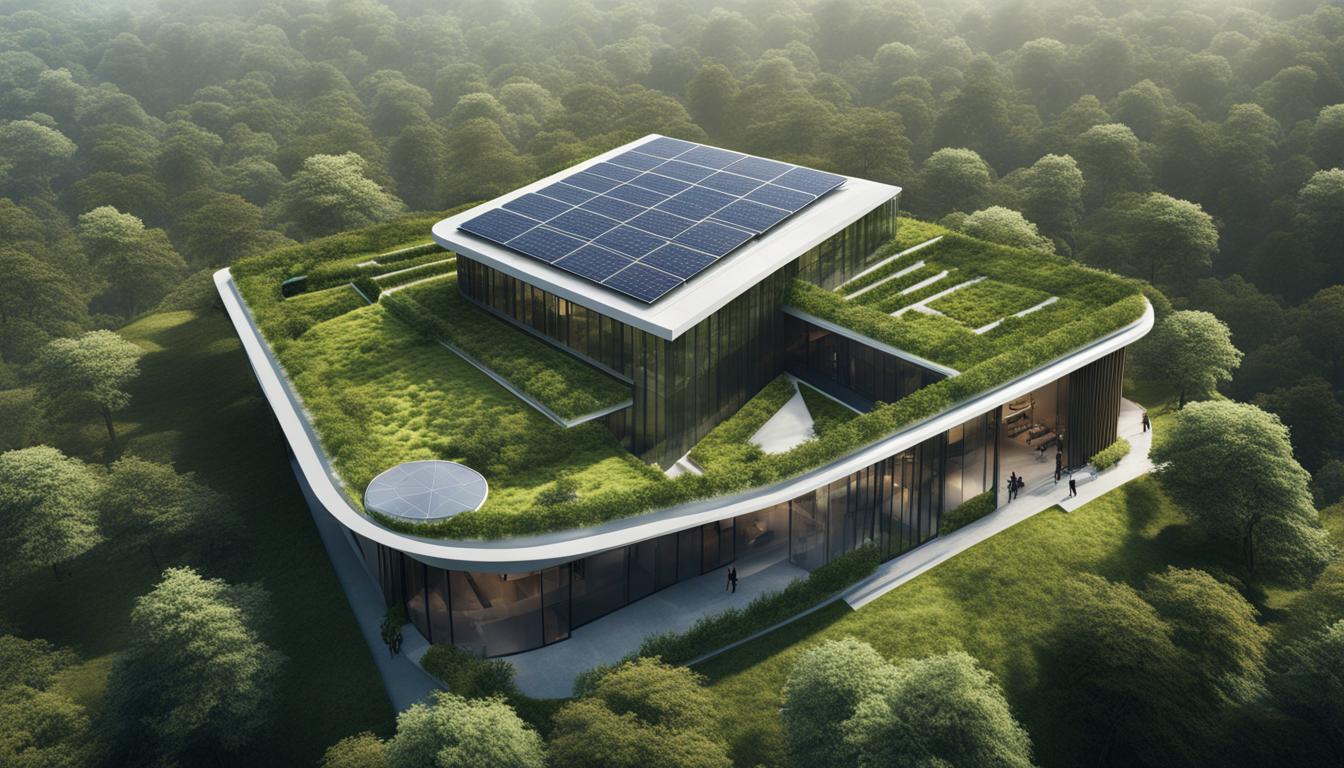Passive solar design is a key component of green building and architecture, focusing on creating energy-efficient buildings through sustainable design practices. By harnessing the power of the sun, passive solar design maximizes the benefits of solar radiation and reduces the reliance on mechanical and electrical devices.
This approach incorporates five essential elements: Aperture/Collector, Absorber, Thermal Mass, Distribution, and Control. These elements work together to capture, absorb, and distribute solar heat, creating comfortable living spaces while minimizing energy consumption.
- Passive solar design enhances energy efficiency in buildings.
- It utilizes sustainable design practices and green materials.
- The five elements of passive solar design are Aperture/Collector, Absorber, Thermal Mass, Distribution, and Control.
- Passive solar heating can be achieved through direct gain and indirect gain approaches.
- Passive solar cooling strategies focus on reducing heat gain and promoting natural ventilation.
The Five Elements of Passive Solar Design
Passive solar design is a sustainable architecture approach that maximizes energy efficiency and minimizes environmental impact. It utilizes natural resources, such as sunlight, to heat and cool buildings, reducing the reliance on mechanical heating and cooling systems. At the core of passive solar design are the five elements that work together harmoniously:
- Aperture/Collector: The key principle of passive solar design is capturing sunlight through a large glass area known as the Aperture/Collector. This allows natural light and solar energy to enter the building.
- Absorber: The Absorber is the surface that absorbs solar heat. It can be a masonry wall, a floor, or even a water container. The Absorber is designed to retain and distribute the captured solar energy throughout the building.
- Thermal Mass: Thermal Mass refers to materials that can store heat. These materials, such as concrete, stone, or adobe, absorb and store solar heat during the day and release it slowly at night, maintaining a comfortable temperature inside the building.
- Distribution: Once solar heat is captured and stored, it needs to be distributed throughout different areas of the building. Distribution methods can include natural convection currents, radiant floor heating, or solar chimneys, ensuring equal distribution of warmth.
- Control: Control elements are essential to regulate and optimize the passive solar system. Roof overhangs, external shading devices, and operable vents offer control over the amount of sunlight and heat entering the building, preventing overheating and maintaining a comfortable environment.
By incorporating these five elements into the design, architects and builders can create sustainable and energy-efficient buildings that promote green building practices. Passive solar design maximizes the use of renewable resources and minimizes the reliance on non-renewable energy sources, reducing carbon footprint and contributing to a greener future.
An Example of Passive Solar Design:
To illustrate these elements in action, let’s consider an example of a passive solar designed home. The Aperture/Collector is a large south-facing window that allows sunlight to enter the living space. The Absorber, in this case, is a masonry wall behind the window that absorbs and retains solar heat. The Thermal Mass includes materials like concrete floors and adobe walls, which store the captured heat. A natural convection system ensures the Distribution of heat throughout the house, with warm air rising and cool air descending. Roof overhangs and operable vents provide Control, allowing the residents to regulate the amount of sunlight and heat entering the space.
By incorporating these five elements into the design, the passive solar home takes advantage of the sun’s energy, reducing the need for conventional heating and cooling systems. This sustainable approach not only benefits the environment but also offers long-term cost savings for the homeowner.
| Element | Description |
|---|---|
| Aperture/Collector | The large glass area that allows sunlight to enter the building |
| Absorber | The surface that absorbs solar heat |
| Thermal Mass | Materials that store heat produced by sunlight |
| Distribution | The method of circulating solar heat throughout the building |
| Control | Features that regulate the flow of heat |
Passive Solar Heating Approaches
Passive solar heating is an eco-friendly construction method that utilizes green building technologies and sustainable building design. It involves harnessing solar energy to provide heat for a building without the need for mechanical or electrical devices. There are two main approaches to passive solar heating: direct gain and indirect gain.
Direct Gain
In direct gain passive solar heating, the actual living space serves as a solar collector, heat absorber, and distribution system. South-facing glass windows or doors allow solar energy to enter the house, and heat-absorbing materials, such as concrete or masonry, store the heat for redistribution. This approach maximizes the amount of solar energy that can be absorbed and utilized within the living space, reducing the reliance on conventional heating systems.
Indirect Gain
The indirect gain approach involves placing thermal mass between the sun and the living space. The thermal mass, typically consisting of materials like stone or concrete, absorbs sunlight and stores the heat. An example of indirect gain is the use of a Trombe wall, which is a thick masonry wall with a glass layer in front. The sunlight heats the wall, and the heat is then radiated into the living space, providing passive heating. This approach is effective in maintaining a consistent temperature within the building, minimizing the need for additional heating.
Passive solar heating approaches are an integral part of sustainable building design and contribute to energy-efficient buildings. By utilizing natural sunlight and thermal storage, these methods reduce the reliance on artificial heating systems and minimize the environmental impact of construction. Implementing passive solar heating techniques in eco-friendly construction projects helps create comfortable and sustainable living environments.

| Direct Gain | Indirect Gain |
|---|---|
| Utilizes the living space as a solar collector | Uses thermal mass to absorb and store heat |
| South-facing glass windows for solar energy entry | Trombe wall with a thick masonry wall and glass layer |
| Heat-absorbing materials store heat for redistribution | Heat is radiated from the thermal mass into the living space |
| Reduces reliance on artificial heating systems | Maintains a consistent temperature within the building |
Passive Solar Cooling Strategies
Passive solar cooling systems play a crucial role in sustainable building design, incorporating green building practices and promoting energy-efficient buildings. These strategies are designed to minimize unwanted heat gain during the day and enhance natural ventilation, creating comfortable and eco-friendly living spaces. By utilizing shading, thermal mass, and natural airflow, passive solar cooling strategies effectively reduce the reliance on mechanical cooling systems, leading to energy savings and reduced environmental impact.
Shading: One of the key strategies in passive solar cooling is effective shading. This involves the use of overhangs, awnings, and vegetation to block direct sunlight from entering the building. By preventing excessive solar radiation, shading helps maintain cooler indoor temperatures and reduces the need for artificial cooling. In addition to enhancing comfort, shading also protects interior furnishings and reduces fading caused by UV rays.
Thermal Mass: The use of thermal mass is another important component of passive solar cooling strategies. Materials such as brick and concrete have high heat storage capacities, allowing them to absorb and store excess heat during the day. By absorbing this heat, thermal mass moderates temperature fluctuations and releases it slowly during cooler periods, maintaining a comfortable indoor environment. The strategic placement of thermal mass within the building’s structure can help regulate temperature and reduce the reliance on mechanical cooling.
Natural Ventilation: Natural ventilation plays a vital role in passive solar cooling, promoting the exchange of fresh outdoor air with warm indoor air. Proper window placement allows for cross ventilation, creating a natural breeze that helps remove heat and maintain a comfortable indoor climate. Wing walls or thermal chimneys can be incorporated into the building’s design to facilitate airflow and enhance natural ventilation. By leveraging natural airflow, passive solar cooling systems reduce energy consumption and create healthier, more sustainable living environments.
By implementing passive solar cooling strategies, sustainable building design can significantly reduce energy consumption, promote green building practices, and create energy-efficient buildings. These strategies work cohesively with other passive solar design principles to optimize energy performance and enhance occupant comfort. Through the combination of effective shading, thermal mass utilization, and natural ventilation, passive solar cooling contributes to a more sustainable and environmentally conscious built environment.
Energy Efficiency and Passive Solar Design
Passive solar design is a sustainable approach to building that promotes energy efficiency and reduces the environmental impact of a home. By incorporating green materials and sustainable design principles, passive solar homes can minimize their carbon footprint and contribute to a healthier planet.
One key aspect of passive solar design is its synergy with energy efficiency strategies. By optimizing insulation, air sealing, and efficient windows, passive solar homes can further reduce heating and cooling loads. This means lower energy consumption and reduced reliance on artificial heating and cooling systems.
Proper site selection is crucial for maximizing the benefits of passive solar design. The orientation and placement of windows play a significant role in maximizing solar gain in the winter and minimizing overheating in the summer. Shading devices such as overhangs, awnings, and vegetation also help regulate solar heat gain, providing comfort year-round.
In addition to optimizing solar gain, passive solar design utilizes thermal mass to store heat and balance temperature fluctuations. Materials with high thermal mass, such as concrete or masonry, absorb and store heat during the day and release it slowly at night, maintaining a more stable indoor temperature.
By integrating passive solar design principles into an energy-efficient home, homeowners can achieve sustainable living and potentially even earn LEED certification. LEED (Leadership in Energy and Environmental Design) is a widely recognized green building certification that emphasizes sustainable design, energy efficiency, and the use of environmentally friendly materials.

In conclusion, energy efficiency and passive solar design go hand in hand to create sustainable and environmentally friendly homes. By optimizing insulation, window placement, and thermal mass, homeowners can reduce their energy consumption and contribute to a more sustainable future.
Importance of Collaboration and Integration
A successful passive solar design requires collaboration and integration among the design team. Everyone involved should have a clear understanding of the design principles and goals. Site selection, orientation, window placement, thermal mass, ventilation, and landscaping all need to be carefully planned and coordinated to achieve the desired outcome.
“Collaboration is key in passive solar design. Architects, engineers, and builders must work together to ensure that all aspects are seamlessly integrated into the design.”
– Jane Johnson, Sustainable Architect
Collaboration during the early stages of the project is essential. Architects need to communicate with engineers to determine the best orientation for optimal solar exposure and to incorporate structural considerations. Builders need to work closely with architects and engineers to bring the design to life, ensuring that all passive solar elements are properly implemented.
An integrated approach is crucial for the success of a passive solar design. Each element, from site selection to landscaping, plays a crucial role in harnessing the benefits of solar energy. By working together, the design team can identify potential challenges and find innovative solutions to overcome them.
The use of computer models and simulations can aid in the collaborative process by allowing the team to visualize the design, assess its performance, and make informed decisions. These tools enable the team to optimize the design, ensuring that all elements work together seamlessly to achieve maximum energy efficiency and occupant comfort.
Furthermore, collaboration and integration extend beyond the design phase. Continuous collaboration between the design team, builders, and occupants is essential to monitor the performance of the passive solar design and make any necessary adjustments. This ongoing collaboration ensures that the design functions as intended and delivers the desired benefits in terms of energy efficiency, comfort, and sustainability.
By embracing collaboration and integration, green building practices can be effectively implemented, resulting in sustainable architecture that utilizes green materials and maximizes the benefits of passive solar design.
As demonstrated, collaboration and integration are key to the success of passive solar design, aligning with the principles of sustainable architecture and promoting the use of green materials. By working together and leveraging the expertise of the design team, a truly sustainable and energy-efficient building can be achieved.
Conclusion
Passive solar design principles provide a sustainable approach to building and architecture. By harnessing the power of the sun, passive solar design offers numerous benefits, including enhanced energy efficiency, reduced heating and cooling loads, and the creation of comfortable living spaces. When designing a successful passive solar home, factors such as proper site selection, strategic window placement, effective shading, insulation, and ventilation must be carefully considered.
Collaboration and integration among the design team are crucial in achieving optimal results. By working together, architects, engineers, and builders can ensure that all aspects of the passive solar design are effectively incorporated into the project. This collaborative approach allows for seamless integration of passive solar principles and maximizes the benefits they provide.
With the growing focus on green building practices, passive solar design is becoming an increasingly important and viable solution for creating eco-friendly and energy-efficient buildings. Its ability to utilize natural resources, such as sunlight, helps reduce dependence on traditional energy sources and minimizes the environmental impact of construction. By embracing passive solar design and incorporating green building technologies, architects and designers can contribute to the sustainable future of the built environment.
FAQ
What is passive solar design?
Passive solar design is an approach that harnesses the power of the sun to heat and cool living spaces without relying heavily on mechanical and electrical devices. It involves utilizing design elements, material choices, and placements to maximize the benefits of solar radiation.
What are the five elements of passive solar design?
The five elements of passive solar design are the Aperture/Collector, Absorber, Thermal Mass, Distribution, and Control. These elements work together to capture and distribute solar heat in a building.
How does passive solar heating work?
Passive solar heating can be achieved through different approaches, such as direct gain and indirect gain. Direct gain involves using south-facing glass to allow solar energy into the house, which is then absorbed by heat-absorbing materials. Indirect gain involves using thermal mass located between the sun and the living space to absorb and transfer heat.
What are passive solar cooling strategies?
Passive solar cooling strategies aim to reduce unwanted heat gain during the day and promote natural ventilation. These strategies can include shading with overhangs, awnings, and vegetation, as well as using thermal mass and facilitating natural airflow through proper window placement and the use of wing walls or thermal chimneys.
How does passive solar design contribute to energy efficiency?
Passive solar design works hand in hand with energy efficiency strategies by optimizing insulation, air sealing, and efficient windows to further reduce heating and cooling loads. Proper site selection, window placement, and shading devices maximize solar gain while minimizing overheating in the summer. The use of thermal mass helps to store heat and balance temperature fluctuations.
Why is collaboration and integration important in passive solar design?
A successful passive solar design requires collaboration and integration among the design team. Everyone involved should have a clear understanding of the design principles and goals. Site selection, orientation, window placement, thermal mass, ventilation, and landscaping all need to be carefully planned and coordinated to achieve the desired outcome.
Source Links
- https://www.energy.gov/energysaver/passive-solar-homes
- https://glowindows.com/10-principles-of-passive-solar-design/
- https://sustainability.williams.edu/green-building-basics/passive-solar-design/
- Regulatory and Compliance: Pioneering the Future of Saudi Arabia’s Dedicated Cargo Airline - December 21, 2024
- Financial Strategies: Fueling the Growth of Saudi Arabia’s Dedicated Cargo Airline - December 20, 2024
- Operational Excellence: Ensuring Competitive Edge for Saudi Arabia’s Dedicated Cargo Airline - December 19, 2024






